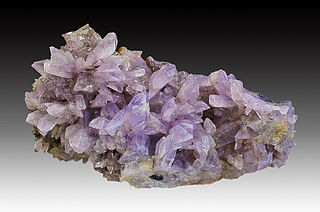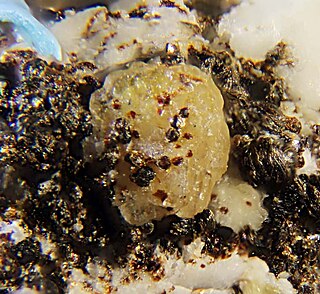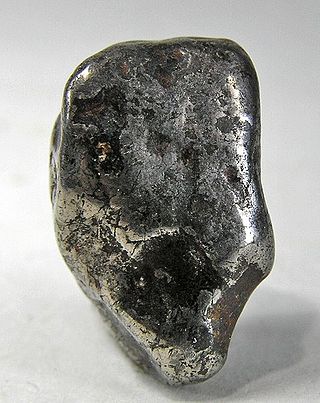
Creedite is a calcium aluminium sulfate fluoro hydroxide mineral with formula: Ca3Al2SO4(F,OH)10·2(H2O). Creedite forms colorless to white to purple monoclinic prismatic crystals. It often occurs as acicular radiating sprays of fine prisms. It is translucent to transparent with indices of refraction of nα = 1.461 nβ = 1.478 nγ = 1.485. It has a Mohs hardness of 3.5 to 4 and a specific gravity of 2.7.

Alunite is a hydroxylated aluminium potassium sulfate mineral, formula KAl3(SO4)2(OH)6. It was first observed in the 15th century at Tolfa, near Rome, where it was mined for the manufacture of alum. First called aluminilite by J.C. Delamétherie in 1797, this name was contracted by François Beudant three decades later to alunite.

Tephroite is the manganese endmember of the olivine group of nesosilicate minerals with the formula Mn2SiO4. A solid solution series exists between tephroite and its analogues, the group endmembers fayalite and forsterite. Divalent iron or magnesium may readily replace manganese in the olivine crystal structure.

Enargite is a copper arsenic sulfosalt mineral with formula Cu3AsS4. It takes its name from the Greek word enarge, "distinct". Enargite is a steel gray, blackish gray, to violet black mineral with metallic luster. It forms slender orthorhombic prisms as well as massive aggregates. It has a hardness of 3 and a specific gravity of 4.45.

Thorianite is a rare thorium oxide mineral, ThO2. It was originally described by Ananda Coomaraswamy in 1904 as uraninite, but recognized as a new species by Wyndham R. Dunstan. It was so named by Dunstan on account of its high percentage of thorium; it also contains the oxides of uranium, lanthanum, cerium, praseodymium and neodymium. Helium is present, and the mineral is slightly less radioactive than pitchblende, but is harder to shield due to its high energy gamma rays. It is common in the alluvial gem-gravels of Sri Lanka, where it occurs mostly as water worn, small, heavy, black, cubic crystals. The largest crystals are usually near 1.5 cm. Larger crystals, up to 6 cm (2.4 in), have been reported from Madagascar.

Cerite is a complex silicate mineral group containing cerium, formula (Ce,La,Ca)
9(Mg,Fe3+
)(SiO
4)
6(SiO
3OH)(OH)
3. The cerium and lanthanum content varies with the Ce rich species and the La rich species. Analysis of a sample from the Mountain Pass carbonatite gave 35.05% Ce
2O
3 and 30.04% La
2O
3.

Fraipontite is a zinc aluminium silicate mineral with a formula of (Zn,Al)3(Si,Al)2O5(OH)4.

Mckelveyite-(Y) is a hydrated sodium, barium, yttrium, and uranium–containing carbonate mineral, with the chemical formula Ba3Na(Ca,U)Y(CO3)6·3H2O.

Corderoite is an extremely rare mercury sulfide chloride mineral with formula Hg3S2Cl2. It crystallizes in the isometric crystal system. It is soft, 1.5 to 2 on the Mohs scale, and varies in color from light gray to black and rarely pink or yellow.

Agrellite (NaCa2Si4O10F) is a rare triclinic inosilicate mineral with four-periodic single chains of silica tetrahedra.
Rhomboclase is an acidic iron sulfate mineral with a formula reported as H5Fe3+O2(SO4)2·2(H2O) or HFe(SO4)2·4(H2O). It crystallizes in the orthorhombic system and typically occurs as tabular crystals with a rhombic outline. It occurs as transparent colorless, blue, green, yellow or grey crystals with a vitreous to pearly luster.

Loparite-(Ce) is a granular, brittle oxide mineral of the perovskite class. It is black to dark grey and may appear grey to white in reflected light on polished thin section with reddish brown internal reflections. It has the chemical formula of (Ce,Na,Ca)(Ti,Nb)O3. Nioboloparite is a variation of loparite-(Ce) containing niobium.

Nahcolite is a soft, colourless or white carbonate mineral with the composition of sodium bicarbonate (NaHCO3) also called thermokalite. It crystallizes in the monoclinic system.

Kegelite is a complex silicate mineral with formula Pb8Al4Si8O20(SO4)2(CO3)4(OH)8.

Awaruite is a naturally occurring alloy of nickel and iron with a composition from Ni2Fe to Ni3Fe.
Banalsite is a rare barium, sodium aluminium silicate mineral with formula: BaNa2Al4Si4O16. Banalsite is a tectosilicate of the feldspar group.

Dzhalindite is a rare indium hydroxide mineral discovered in Siberia. Its chemical formula is In(OH)3.
Carbokentbrooksite is a very rare mineral of the eudialyte group, with formula (Na,□)12(Na,Ce)3Ca6Mn3Zr3NbSiO(Si9O27)2(Si3O9)2(OH)3(CO3).H2O. The original formula was extended to show the presence of cyclic silicate groups and silicon at the M4 site, according to the nomenclature of eudialyte group. Carbokenbrooksite characterizes in being carbonate-rich (the other eudialyte-group species with essential carbonate are zirsilite-(Ce), golyshevite, and mogovidite). It is also sodium rich, being sodium equivalent of zirsilite-(Ce), with which it is intimately associated.

Zirsilite-(Ce) is a very rare mineral of the eudialyte group, with formula (Na,□)12(Ce,Na)3Ca6Mn3Zr3NbSi(Si9O27)2(Si3O9)2O(OH)3(CO3)·H2O. The original formula was extended to show the presence of cyclic silicate groups and the presence of silicon at the M4 site, according to the nomenclature of the eudialyte group. Zirsilite-(Ce) differs from carbokentbrooksite in cerium-dominance over sodium only. Both minerals are intimately associated. The only other currently known representative of the eudialyte group having rare earth elements (in particular cerium, as suggested by the "-Ce)" Levinson suffix in the name) in dominance is johnsenite-(Ce).

Minrecordite, CaZn(CO3)2, is a very rare mineral belonging to the dolomite group, the member with Ca and Zn. It was discovered, associated with dioptase, in a specimen from the Tsumeb mine (Namibia), which is consequently its type locality. Its name is a tribute to The Mineralogical Record magazine, representing the collaboration between professional and amateur mineralogists. In this locality it is associated primarily with dioptase, and less frequently with duftite, calcite and malachite. It is a rare mineral, which has been found only in a few deposits in the world. In addition to the type locality, it appears in the Preguiça mine, in Moura, district of Beja (Portugal).

















